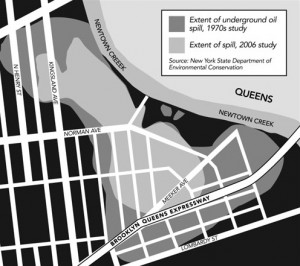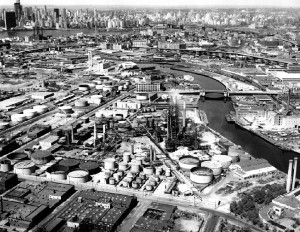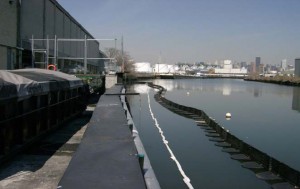
Problems
Oil spill
In 1978, Greenpoint, Brooklyn, experienced one of the most serious oil spills in U.S. history. A main pipeline at an ExxonMobil refinery ruptured, releasing about 17 million gallons of oil over several weeks. Much of the oil leaked into the water, and some of it came ashore. After the incident, ExxonMobil was required to clean up the soil and groundwater in the area of the spill. However, the cleanup process continued for many years, and some areas are still considered contaminated. This Greenpoint oil spill incident has become one of the symbols of environmental problems in the United States. As a result of the incident, steps were taken to improve oilfield and oil transportation controls and improve technology and safety procedures at refineries and tank farms. In addition, work has been done to clean up the soil and water at Greenpoint, although contamination is still a problem for the area.
Causes
The primary cause of the Greenpoint oil spill was a technical failure at the Bouchard Transportation tank farm. The pipeline rupture was the result of corrosion caused by prolonged operation and inadequate maintenance of the infrastructure. Other primary causes of the Greenpoint oil spill included: ● Deficiencies in maintaining and servicing oil pipelines and tank farms. Oil pipelines and tank farms require constant maintenance and regular servicing to ensure their safe operation. When such work is not done properly, an oil spill is risky. ● Disturbances in oil transportation processes. Oil is transported through pipelines and transportation vessels, and if the transportation processes are not properly controlled, various incidents such as oil spills can occur. ● Failures in oil spill prevention measures. When necessary precautions such as personnel training, equipment inspection, and control points are not followed, the risk of an oil spill occurs. ● Geographic features of the area. Greenpoint has long been the center of the refining industry, and the presence of tank farms and pipelines in the area posed an increased risk of oil spills. These causes are common to many oil spills, and regular precautions and monitoring of oil transportation processes are necessary to prevent such incidents. However, it should be noted that the Greenpoint oil spill was not the only pollution incident in the area. There have been numerous refineries and tank farms in Greenpoint in the past that have left a significant mark on the environment. At the same time, insufficient measures to control the environmental effects of the plants also caused serious environmental pollution in the area. Thus, the causes of the oil spill were related to inadequate maintenance of infrastructure and inadequate monitoring of refineries and tank farms in the past.
Consequences
This spill caused serious environmental pollution in Greenpoint and surrounding areas. The aquatic and coastal ecosystems were severely damaged, and area residents faced water supply and air pollution problems. The oil spill has had serious environmental, health, and economic consequences for the area. Some of these include: ● Ecosystem damage. Huge amounts of oil spilled into New York Bay damaged the aquatic ecosystem and polluted the shoreline. Many species of fish and other animals have died or suffered serious consequences from contact with the oil. ● Air Pollution. The release of oil vapors into the atmosphere has caused air pollution in Greenpoint and surrounding areas. This has led to several health problems in the population, such as respiratory problems and other illnesses. ● Negative impact on the economy. The Greenpoint oil spill hurt the local economy, including the fishing industry and tourism. It has also resulted in additional costs to clean up the oil in the area. ● Human Health. Greenpoint residents who were near the oil spill experienced health problems related to contact with oil and petroleum products. ● Water supply problems. The oil spill damaged the water supply systems in Greenpoint, which could lead to temporary or long-term drinking water problems. As a result of the Greenpoint oil spill, measures were taken to improve safety in the transportation and storage of oil, as well as to clean up the environment. However, contamination at Greenpoint is still a problem, and work continues to be done to clean up the oil in the area.
Gallery
3Timelines
2020
Much of Greenpoint has already been cleaned up and converted into a park. Despite this, the environmental effects of the oil spill are still being felt in the area. Traces of oil continue to be found in the area, and groundwater continues to be contaminated.
2019
Some residents continue to complain about problems related to the Greenpoint oil spill, including the smell of oil and health problems. At the same time, NY DEC reported that more than 8.7 million gallons of oil and petroleum products have been removed from the soil and ground in Greenpoint.
2010
The New York State Department of Environmental Conservation (NY DEC) submitted a Greenpoint cleanup plan that was approved by the city government. The Greenpoint Waterfront Association for Parks and Planning (GWAPP) is beginning work to transform Greenpoint into a park. This work includes extensive cleanup and ecosystem restoration.
2005
The New York Times publishes a new article stating that Greenpoint's pollution problem is still unresolved and that the spill is much larger than officially reported.
2004
Riverkeeper sues ExxonMobil, alleging environmental violations and demanding a comprehensive cleanup of the area. As a result of the lawsuit, ExxonMobil agrees to pay $25 million to clean up the site.
1990
June 18
Greenpoint residents begin complaining about the smell of oil and sewage in the area. They ask ExxonMobil and local authorities to clean up the area. Pressure from residents and organizations, including Greenpeace, lead to the creation of several groups studying Greenpoint's pollution problem.
1988
January 01
Mobil’s Greenpoint terminal leaks 35,000 gallons of unleaded gasoline. Dangerous vapors invade a city sewer under North Henry St.
1978
September 02
An oil spill occurs at an ExxonMobil plant, affecting about 17 million liters of oil. Much of this oil ends up in the ground and then in groundwater. The company is not doing enough to clean up the area and protect the environment. Reports of problems at Greenpoint have begun to appear in the press. In particular, The New York Times published an article stating that Greenpoint had more than 17 million gallons of petroleum products seeping into the soil.
1950
October 05
Several oil refineries begin operating on Greenpoint, located on the banks of the East River. Within a few decades, they become the area's major employers and attract many workers and residents. The oil and petroleum products used in production begin to seep into the soil and ground in Greenpoint, causing environmental pollution.

